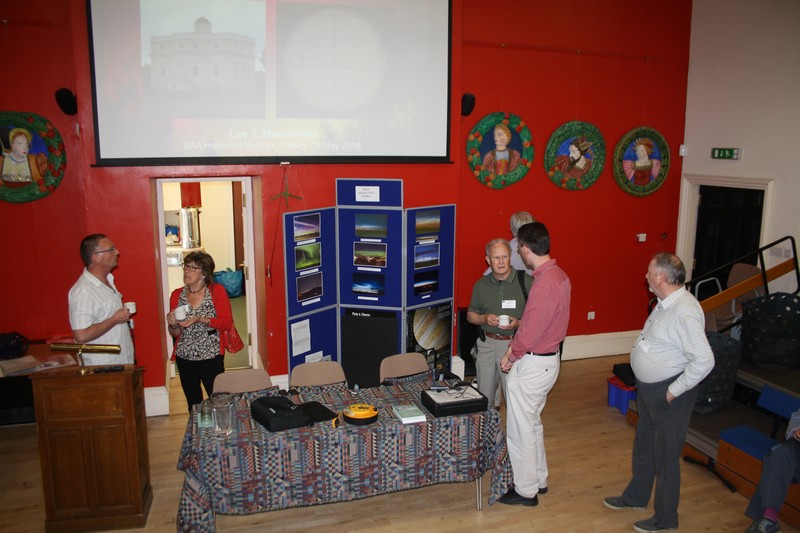2018 – Stirling Meeting
Our section meeting for 2018 was held in the beautiful city of Stirling. We met at the Smith Gallery and Museum, meeting place of Stirling Astronomical Society.
Our speakers:
Dr Lee Macdonald – “Kew Observatory and the birth of solar-terrestrial physics”
Lee Macdonald, the deputy director of the historical section, opened the meeting by telling us about his researches into the Kew Observatory (the subject of his doctoral thesis). Kew Observatory was built by George III as a private observatory for the Royal Family. The observatory went on to become a solar and magnetic observatory, and then a testing ground for scientific instruments. It is considered the forerunner of the National Physical Laboratory.
John Rosenfield – “Fear and Loathing: the moons of Mars”
John Rosenfield outlined the extraordinary history of the two moons of Mars – Phobos and Deimos (which mean “fear” and “loathing”). There’s an unexpected link to Gulliver’s Travels – the astronomers of Laputa described two moons of Mars in Swift’s book, even though the two moons weren’t discovered for more than a century after it was written. Mysteries continue to the present day; perhaps some will be answered by future probes to the moons.
Before the lunch break, Sandra Brantingham, director of the Aurora and Noctilucent Cloud Section, gave a short presentation about the work of the section. There was great interest in STEVE, the recently discovered auroral feature, with several attendees saying they may have seen or even photographed it.
During the lunch break, many delegates took the chance to tour the Smith Museum. Among the exhibits is the world’s oldest football, found in the rafters of Stirling Castle. It was probably kicked there during the time of Mary Queen of Scots.
The afternoon program:
Bill Barton – “Alice Grace Cook – an East Anglian meteor observer”
Bill Barton lectured on an important figure from the early years of the British Astronomical Association. Alice Grace Cook (1877-1958) was one of the first female fellows of the Royal Astronomical Society and director of the BAA Meteor Section. Very little is known about her, though. The presentation described her life and her contributions to astronomy. She is best-known for her independent discovery of Nova Aquilae in 1918, but perhaps her most significant contribution to astronomy was to sponsor the membership applications for many significant figures from the history of the BAA.
Dr Dave Gavine – “Thomas Dick of Dundee”
Our keynote speaker was Dr Dave Gavine, former director of the BAA Aurora Section, and a well-known figure in Scottish astronomical circles. He told us about a colourful character from Scottish astronomical history. Thomas Dick wrote a number of scientific/religious tracts, which were popular at home and abroad. They were the inspiration for many famous astronomers – for example Edward Emerson Barnard.
Dr Vanessa Smer-Barreto – “Mayan Astronomy”
Dr Smer, from Mexico, is a recent graduate of the Royal Observatory, Edinburgh. Her talk explored the place and importance of astronomical practice in Mayan society: its agricultural cycle, war endeavours, and human sacrifices. We looked at this culture’s knowledge of Venus, the Sun, the Moon, eclipses, calendars, the Milky Way, constellations, and their progress in mathematics.
Dr Bruce Vickery, who was originally scheduled to speak about the Calton Hill Observatory in Edinburgh, had to pull out because of ill-health. However, we were delighted that he could attend as a delegate for part of the day. He brought along copies of the booklet he has written about the observatory. I still have some copies, which I’d be happy to pass on to section members.
On both Friday and Saturday evening, parties visited the historical observatory on the top of the Highland Hotel.
Thanks to Stirling AS, for hosting our meeting.
Thanks to Vincent and Jakki of the Smith Gallery for helping us out on the day.
And a special mention for Oswald, the museum cat. You can find Oswald’s web page here.
Click here to return to the Section home page.
| The British Astronomical Association supports amateur astronomers around the UK and the rest of the world. Find out more about the BAA or join us. |
